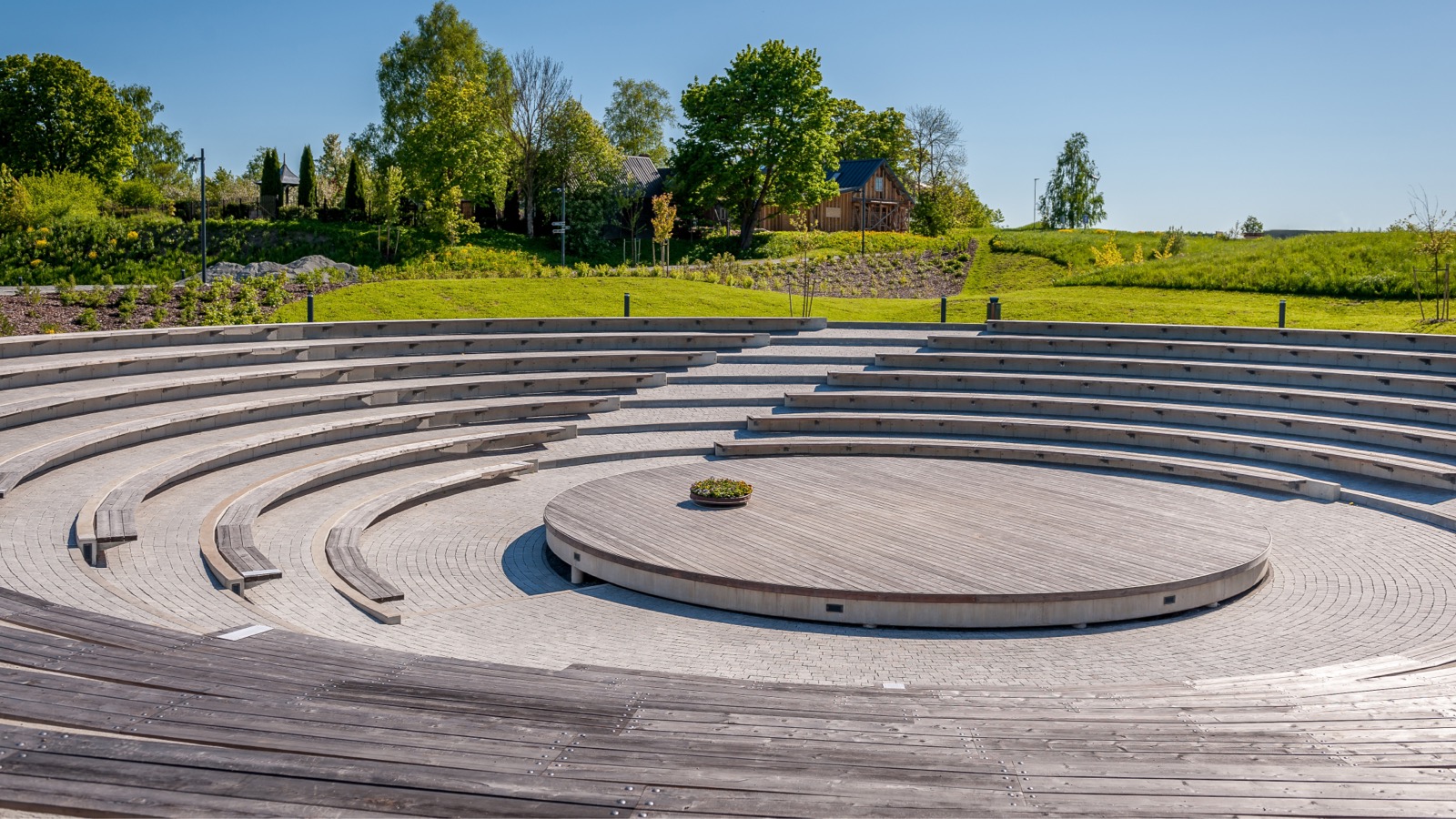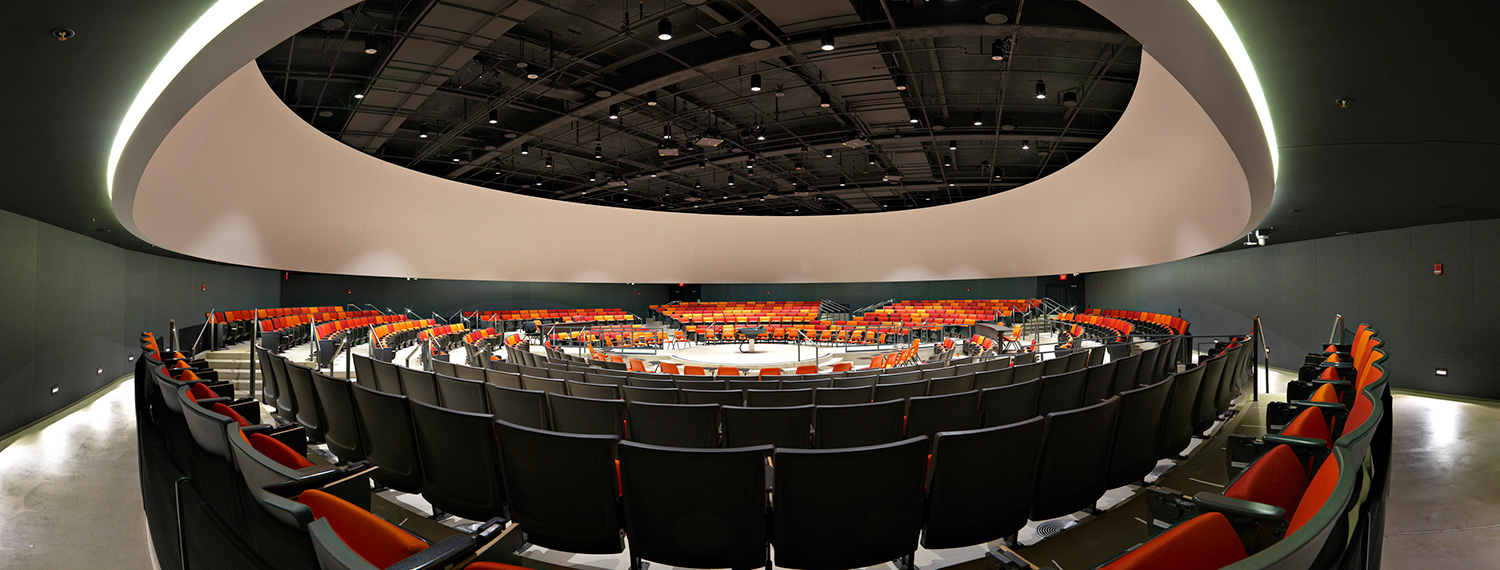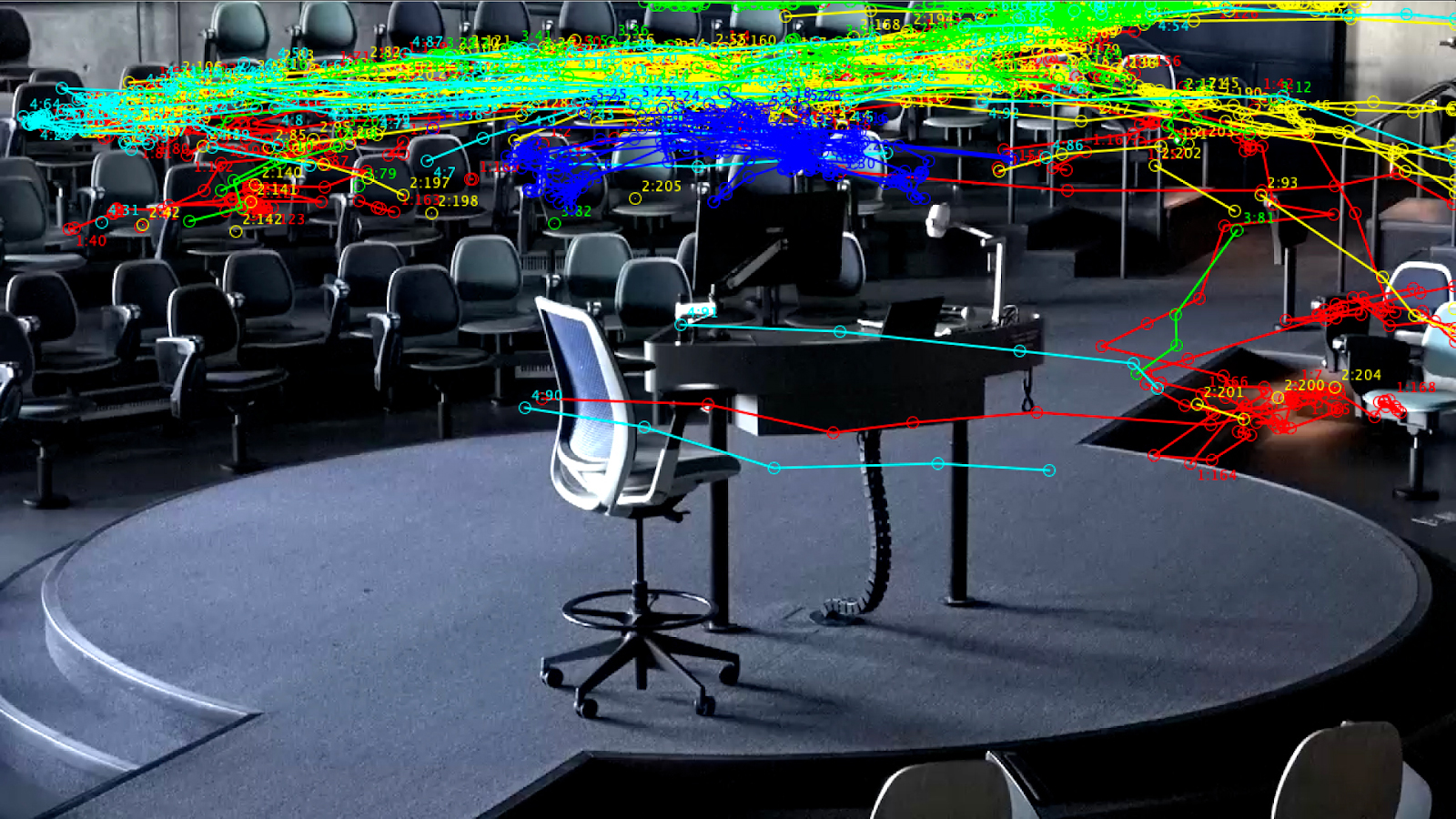Colleges and universities often need to balance educating a great number of students with the desire to encourage interactive and engaging teaching styles. One innovative approach is learning-in-the-round classroom design.

Faculty and students face a challenging situation when they come across unfamiliar learning space designs. This situation also affects the staff members supporting these innovative environments. Oregon State University (OSU) and the University of California, Riverside (UCR) faced such circumstances when they introduced their learning-in-the-round spaces in 2015 and 2021, respectively. The lesson learned at both institutions is that the key to facilitating successful experiences in unprecedented learning spaces involves interactions among instructors, a careful assessment of outcomes, collaboration among like-minded colleagues, and close attention to critical voices.
Recently, higher education leaders have paid significant attention to redesigning and constructing engaging classrooms. The effective implementation of these enhanced engagement strategies is often achieved by introducing more intimate conditions that support learner-learner interactions, learner-instructor interactions, discussion, group work, and collaboration.Footnote1 Typically, this drive for enhanced engagement classrooms tends toward smaller instructional spaces, accommodating less than 30 students, with easily reconfigurable chairs, desks and tables, whiteboards, and/or wall-mounted screens. However, large public universities are responsible for educating a great number of students. This responsibility leads to a reliance on large lecture halls. The need to balance this responsibility with the desire to encourage interactive and engaging teaching styles requires an innovative approach to classroom design. The challenge is to promote enhanced engagement in large classrooms while also reducing the perceived size of the classroom.
We define learning-in-the-round spaces as teaching spaces where learners sit within concentric circles around a central presentation area so that all learners face one another. This design concept is consistent with RG Gregory's definition of "Theater in the Round." Models of in-the-round design were taken from performing arts and television.Footnote2 OSU developed this design with Bora Architecture & Interiors in three learning spaces (176, 277, and 588 fixed seats, respectively) for the Learning Innovation Center (LINC), which opened in the fall of 2015 (see figure 1). UCR developed a similar design with 404 seats for the new Student Success Center in 2021.

We are aware of similar learning-in-the-round spaces (with seat count) at the College of Dental Medicine at Roseman University (150), Washington State University (150), Texas A&M University (204, 365, 605), Indiana University (120), the University of Michigan (190), Iowa State University (62), and Monash University, Australia (140). Additional learning-in-the-round spaces may exist elsewhere.
Since 2015, faculty and administrators from more than 100 higher education institutions and architecture firms have visited OSU to study learning in the round. Several developed their own round learning spaces with unique and innovative variations. They attended classes, met with OSU faculty and students, and conferred with classroom technology and support leadership. UCR and OSU continue to work together in faculty engagement and research, confirming the value of continued interinstitutional collaboration for advancing effective uses of learning-in-the-round spaces.
Why Teach in the Round?
The learning-in-the-round design intends to bring learners and instructors closer together, allowing for increased social connection through the front-facing visual and auditory orientation of learners. OSU's rooms accommodate upward of 176, 277, and 588 students with only five and nine rows, respectively, while UCR's room accommodates 404 students with only eight rows. This closeness allows for engagement and a sense of intimacy not possible in other large classrooms. Manuela Martins-Green, UCR professor of cell biology and neuroscience, said she has "enormous engagement" when teaching in the classroom in the round: "I have eight rows . . . and I can see them all, and I can have eye contact with [students] at any one point." Similarly, Ward Beyermann, UCR professor of physics and astronomy, commented on the benefits of students being able to see each other: "The engagement with the students was really, really good. . . . [I]n traditional lecture halls, students are always looking at the back of the heads of other students. The other thing they do is they see their laptops, and a lot of times, they see social media on their laptops which tends to make them disengage." Professor Beyermann also noted that students are not only looking at one another but also speaking with one another when they address the class. Rather than seeing the backs of students' heads when answering questions, students can easily see other students' faces and reactions in classrooms in the round.
Dynamic seating also allows every other row in the UCR classroom in the round to rotate, allowing students to quickly and easily move into small groups. This ability to change seating direction, coupled with eight projector screens capable of showing two independent sources from any part of the room, means that students do not need to stretch their necks to see what the instructor is projecting. The seating arrangement also allows instructors to move through the rows of the classroom with greater ease, enabling them to talk with students one-on-one or in small groups more regularly and also to hand off devices such as microphones or tablets for students to do work that instructors can project for all students to see. Additionally, since this expanded accessibility creates greater mobility for students, instructors are encouraged to incorporate student movement into their classrooms. Research suggests increased executive function and working memory capabilities when students are standing.Footnote3
Faculty also praised the OSU and UCR classrooms in the round for their use of light. The rooms let in a significant amount of natural light, which helps maintain circadian rhythms. In addition, research suggests that the high ceilings of classrooms in the round (e.g., 22 feet for the UCR classroom) are correlated with a sense of freedom and relational processing, allowing students to discern commonalities or higher-order abstract processes.Footnote4
Research
Researchers at the XCITE Center for Teaching and Learning at UCR, led by Eric Johns, conducted an observational study to evaluate the impact of learning-in-the-round design.Footnote5 The study quantified instructors' movements in the classroom as a means of measuring their activity. While a comparison of teaching practices using the Classroom Observation Protocol for Undergraduate STEM (COPUS) did not reveal a significant difference in teaching practices between traditional lecture halls and classrooms in the round, the researchers found a significant difference in overall movement by instructors. To study this, the researchers recorded 50 minutes of four classes led by six different instructors—three in traditional lecture halls and three in the classroom in the round—and tracked instructors' movement using MTrackJ software. They calculated the total motion of each instructor using an Area Under the Curve analysis, which revealed that overall motion increased in the classrooms in the round, regardless of the teaching style (see figure 2). Additionally, the study found a correlation between total motion by instructors and active learning strategies in the classroom in the round. This correlation suggests that reduced space of the round design may better facilitate active instruction styles.

The Geometry of Learning Dynamics group (GOLD) began in 2014 to develop research and assessment of learning in the round. The research team includes Jon Louis Dorbolo (OSU, University Information and Technology), Lynne L. Hindman (OSU, Education, and original GOLD team member), Becky Warner (OSU, Sociology and senior project leader for LINC), Kim DeBacco (UCLA, Online Teaching and Learning, formerly UCR), Bill Loges (OSU, New Media Communications), Kate Feiertag (Bora Architecture & Interiors), Mary Shannon Williams (Lincoln Land Community College, formerly Texas A&M). Studies underway are analyses of institutional data, interviews of faculty teaching in the classroom in the round, and location studies of students' seating behaviors. Semi-structured interviews conducted in person with thirteen OSU instructors who taught in the 588-seat space over the first two years (fall 2015 through fall 2017) revealed perceived advantages and challenges that aligned with the experiences of the UCR faculty present at a collaborative symposium held at UCR in March 2023.
Perceived Advantages
Most of the instructors participating in the OSU research highly valued their closer proximity to learners; several of them described their classroom experience as "intimate." They preferred teaching in the round over returning to a rectangle room. Most of the instructors teaching in the classroom in the round reported increased interaction with and among students. They experienced increases in students' positive behaviors, with a decrease in disruptive behavior. They reported developing movement and communication strategies to address the circular arrangement and the fact that they have their back to some students all the time. Some of the faculty completely remade their presentation media and strategies to take advantage of in the classroom-in-the-round features. In contrast, others made minimal adjustments; teaching in the classroom in the round supports but does not require pedagogical revision. Overall, OSU instructors who taught large enrollment sections in the classroom in the round preferred that environment over traditional, rectangular lecture halls. However, this preference does not suggest that rectangle rooms are less effective for teaching and learning—only that the learning-in-the-round design provides advantages that many faculty employ to enhance their teaching.
Perceived Challenges
Faculty at OSU and UCR have also noted some perceived challenges to teaching and learning in the round. One of the most common challenges is the fear of having their back to students, which can be unsettling for some faculty members. However, once faculty have taught in the room, this fear goes away. Faculty respond to the challenge by developing plans on how to walk around the lectern. Some instructors come to use their movement and directionality in the circle to their advantage when engaging with learners.
Additionally, administering exams in this type of classroom can be tricky because the heightened visibility of other students increases the possibility that students will see other students' work. Exams require a certain level of organization and planning. The challenge can be met by assigning distanced seats, issuing multiple versions of the exam, or using a testing facility.
Other challenges include a heightened need for training faculty to make the most effective use of the room, requiring close collaboration between academic technologies staff supporting technology and teaching and learning staff supporting pedagogical strategies. Having both groups work together may present issues but can also open up avenues of collaboration benefiting both instructors and students.
Confirmation through Collaboration
In October 2021, UCR virtually hosted OSU faculty and staff for the "Teaching in the Round: Faculty Summit" to share experiences and knowledge with UCR faculty who were preparing to teach in the newly opened classroom in the round. A follow-up symposium in March 2023, organized by Richard Lawrence Edwards, executive director for the XCITE Center for Teaching and Learning, UCR, brought representatives from OSU and UCLA to the UCR campus for presentations of ongoing research and for discussions with faculty who had taught or were preparing to teach in the classroom in the round. This sharing of experiences, discoveries, and resources has proved to be valuable for both campuses. In both 2021 and 2023, UCR and OSU faculty and staff found consensus on the advantages and challenges of teaching in classrooms in the round.
Upcoming summits will undoubtedly result from the success of the UCR-OSU collaboration. College and university instructors and staff can use the classrooms in the round to share experiences and strategies as we all advance collaboration through research and assessment of teaching and learning in the round.
Notes
- Omolola A. Adedokun, Loran Carleton Parker, Jaqueline N. Henke, and Wilella D. Burgess, "Student Perceptions of a 21st Century Learning Space," Journal of Learning Spaces 6, no. 1 (2017); Victoria Holec and Richelle Marynowski, "Does It Matter Where You Teach? Insights from a Quasi-Experimental Study on Student Engagement in an Active Learning Classroom," Teaching and Learning Inquiry 8, no. 2 (2020). Jump back to footnote 1 in the text.
- See Mick Fealty's interview with RG Gregory: "A Life Lived in the Round," YouTube, August 15, 2012. Jump back to footnote 2 in the text.
- Ranjana K. Mehta, Ashley E. Shortz, and Mark E. Benden, "Standing Up for Learning: A Pilot Investigation on the Neurocognitive Benefits of Stand-Biased School Desks," International Journal of Environmental Research and Public Health 13, no. 1 (2015). Jump back to footnote 3 in the text.
- M. G. Figueiro and M. S. Rea, "Office Lighting and Personal Light Exposures in Two Seasons: Impact on Sleep and Mood," Lighting Research & Technology 48, no. 3 (2016); Joan Meyers‐Levy and Rui Zhu, "The Influence of Ceiling Height: The Effect of Priming on the Type of Processing That People Use," Journal of Consumer Research 34, no. 2 (2007). Jump back to footnote 4 in the text.
- Eric Johns et al., "Disruption in the Round: Visualizing Movement in Innovative Lecture Halls," unpublished manuscript, 2023. Jump back to footnote 5 in the text.
Eric Johns is Archivist and Curator for the Stone Center for Latin American Studies at Tulane University.
Jon Louis Dorbolo is Professional Knowledge Developer for University Information and Technology and Philosophy Instructor for the School of History, Philosophy, and Religion at Oregon State University.
© 2023 Eric Johns and Jon Louis Dorbolo. The text of this work is licensed under a Creative Commons BY-NC-SA 4.0 International License.
